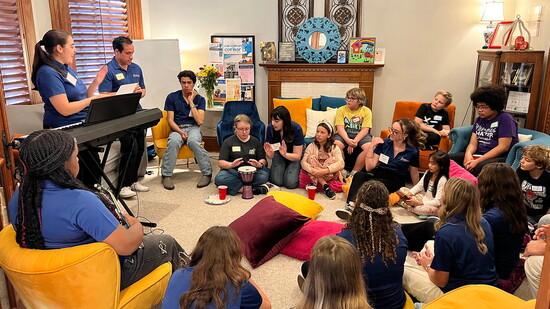On a quiet evening in Pensacola, laughter echoes from the Chadbourne Foundation Home. Children run through the halls, settle into art tables, and gather in circles where stories are shared and tears are met with understanding. At first glance, it could be mistaken for an after-school program or a youth club. But this is Valerie’s House, a sanctuary where children and teens who have lost a parent or sibling come together to grieve, to heal, and, most importantly, to know they are not alone.
A Child’s Perspective
“When I first came, I felt nervous,” Lily admits. “I didn’t know anyone. But then I started to make friends…and I got more comfortable.”
For many children, the first day at Valerie’s House is filled with uncertainty. The weight of loss is heavy, and they’re unsure if anyone could understand. But here, something changes. Emma, another young participant, explained it this way: “At school, I only knew maybe one person who had gone through something similar. But here, everyone knows. I felt an instant connection, like they understood what I was going through.”
That connection is the heart of Valerie’s House. It turns isolation into belonging. A child who once struggled to speak about loss begins to laugh again, to share memories, and to find comfort in the presence of peers who get it.
Healing Through Friendship and Expression
Friendships form quickly within these walls. Hannah remembers meeting her first peer friend here, Frankie, and feeling the “click” that helped her settle in. “Being around kids close to my age who understand—it made all the difference,” she says.
Valerie’s House also gives children safe, creative outlets to process grief. Laney recalls one exercise vividly: “We listed feelings we didn’t like about grief on a board, and then threw wet cotton balls at them. It helped me get all the bad emotions out.”
Whether it’s art, journaling, games, or simply sitting in a circle and talking, every activity is designed to ease children into sharing—especially the middle and high schoolers who often keep their emotions locked inside. Graham reflects, “I was really confined before I came here. But talking—just talking—helped me more than anything.”
What the Children Discover
Over time, the shift is profound. What once felt impossible—laughing, dreaming, feeling “normal” again—becomes reality. “I can live a more normal life now,” Graham says quietly. “It doesn’t mean my grief went away, but I don’t feel like the only one anymore.”
Emma adds that Valerie’s House has shaped how she thinks about grief moving forward: “It’s not something that ever really goes away. But now I know I’ll always find people here who are going through it too. I’ll always have ways to deal with it.”
Why This Work Matters
Crista Brandt, Director of Valerie’s House Northwest Florida, knows this truth all too well. She lost her own mother at just 11 years old. “This work is deeply personal to me,” she shares. “Our mission is that no child will grieve alone. That means giving them the tools to process grief in healthy ways—so they don’t grow up carrying trauma in silence.”
She emphasizes that grief left unsupported can affect not just one child, but an entire community—leading to challenges like depression, addiction, school struggles, even incarceration later in life. “By intervening early, by surrounding children with support, we are changing futures—not only theirs but the future of our region,” Crista explains.
Gratitude and Growth
The children themselves are quick to express gratitude. “I just want to say thank you,” Graham says simply. Laney adds, “This place makes the world a better place. Every day, Valerie’s House is starting one life at a time.”
Emma speaks with heartfelt clarity: “I couldn’t even begin to explain how much this has helped me, or how grateful I am to the people who make it possible. It’s put me so much farther in life than I ever thought I could be.”
Looking Ahead
By 2026, Valerie’s House Northwest Florida will become its own independent entity, strengthening local governance and tailoring programs to the 13,000 children in our region who will lose a parent or sibling before turning 18.
The vision is bold but simple: to ensure that no child in Northwest Florida grieves alone.
And if you ask the children themselves, they’ll tell you the same thing—this place is more than a program. It’s a second home. It’s proof that grief, while it changes life forever, doesn’t have to take away joy, hope, or the courage to dream again.
